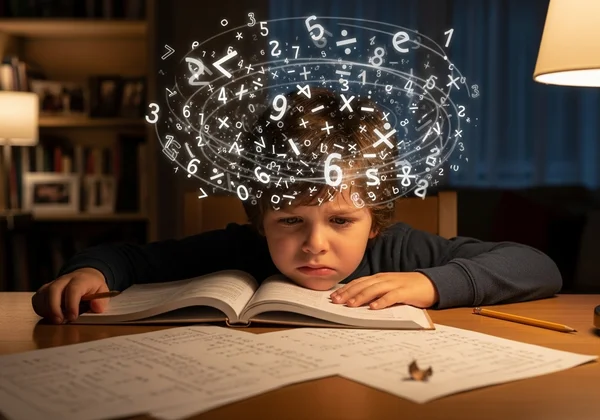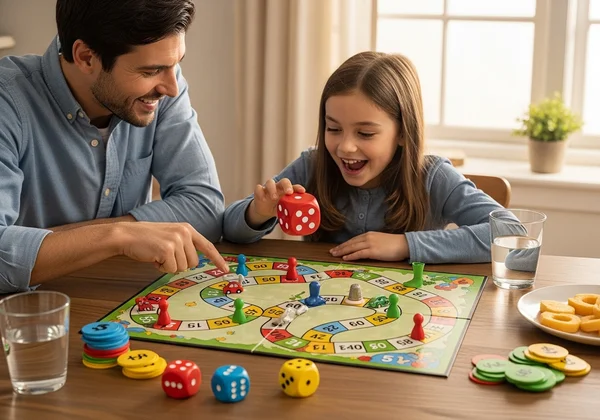Dyscalculia Test & Home Strategies: Supporting Your Child
Are you a parent watching your child struggle with math, feeling frustrated and unsure how to help? You're not alone. The tears over homework, the resistance to number-based tasks, and the falling grades can leave any parent feeling helpless. Many wonder, is it dyscalculia or are they just bad at math? This guide is here to provide practical, empathetic strategies for dyscalculia support for kids right in your own home, helping you turn math challenges into opportunities for growth and confidence.
To provide effective help, first understand the root of the struggle. Before diving into strategies, gaining clarity on your child’s specific challenges can make all the difference. An initial screening can provide valuable insights into their learning profile. You can gain some clarity with a comprehensive assessment designed by experts.
Understanding Dyscalculia in Your Child
Before you can effectively help, it’s crucial to understand what dyscalculia is—and what it isn’t. Dyscalculia is a specific and persistent learning disability involving innate difficulty in understanding numbers, learning number facts, and performing calculations. It's not a reflection of a child's intelligence or their effort. It's a neurodevelopmental difference in how the brain processes numerical information. Recognizing this is the first and most important step in providing the right kind of support.

What Dyscalculia Looks Like in Young Learners
The signs of dyscalculia in children can vary by age but often point to a core difficulty with number sense. In young learners, you might observe:
- Trouble learning to count and associating numbers with quantities.
- Difficulty recognizing printed numbers (e.g., confusing 6 and 9).
- A heavy reliance on finger counting long after peers have moved on.
- Struggles with sorting objects by size, shape, or color.
- An inability to remember basic math facts like 2 + 3 = 5.
- Challenges with understanding concepts like "more than" or "less than."
For a teenager, these challenges might evolve into difficulty with multi-step problems, understanding graphs and charts, or managing money. Identifying these patterns is key to seeking the right kind of help, such as a targeted dyscalculia test for teenagers.
Distinguishing Dyscalculia from General Math Struggles
It's normal for children to struggle with a new math concept occasionally. The key difference with dyscalculia is the persistence and pattern of the difficulties. A child who has trouble with long division but excels at fractions may just need more practice with that specific skill. However, a child with dyscalculia shows a consistent and often profound difficulty across multiple areas of mathematics, regardless of the quality of teaching or amount of tutoring. Their struggles are not due to laziness; their brains are simply wired differently for processing numbers. Understanding this distinction is vital for helping your child with math in a compassionate way.
Practical Dyscalculia Homework Help Strategies
Homework time is often a major source of stress for families dealing with dyscalculia. The goal is to transform it from a battleground into a productive, low-stress learning session. Providing effective dyscalculia homework help focuses on building understanding, not just finding the right answer.
Breaking Down Problems & Using Visual Aids
Children with dyscalculia often feel overwhelmed by a page full of numbers and symbols. Your role is to be their translator and organizer.
-
Break It Down: Cover up all problems except the one your child is working on. For multi-step problems, write each step on a separate sticky note.
-
Use Graph Paper: This simple tool can help your child align numbers correctly in columns for addition, subtraction, and multiplication problems.
-
Embrace Manipulatives: Use physical objects like LEGOs, beads, or even dried beans to represent numbers. This makes abstract concepts concrete and tangible.
-
Use visual aids: Draw pictures to illustrate word problems. A visual representation can bridge the gap between language and mathematical concepts.

Creating a Positive & Patient Learning Environment
Your attitude during homework time sets the tone. A supportive learning environment is non-negotiable for a child who already feels anxious about math.
- Establish a "No-Shame Zone": Make it clear that mistakes are learning opportunities, not failures. Praise their effort and persistence above all else.
- Be Patient: Your child may need to hear an explanation multiple times in different ways. Avoid showing frustration, as this will only increase their anxiety.
- Take Frequent Breaks: Watch for signs of overload, like fidgeting or shutting down. Short, focused work periods are far more effective than one long, draining session.
Everyday Dyscalculia Support for Kids
Math isn't confined to worksheets and textbooks. The best way to build a child's confidence and skills is to integrate number concepts into daily life in fun, low-pressure ways. This approach helps them see math as a useful tool rather than a source of dread. The first step towards this is understanding their specific needs, which is possible through a reliable dyscalculia screening.
Incorporating Math into Daily Routines & Play
Turn everyday activities into gentle learning opportunities.
- In the Kitchen: Let your child help with measuring ingredients while baking. This teaches fractions, volume, and sequencing.
- At the Store: Ask them to find a specific number of items (e.g., "Can you get me 5 apples?"). Older kids can help estimate the total cost or calculate change.
- Setting the Table: This simple chore involves one-to-one correspondence, counting, and sorting.
Games & Resources to Build Number Sense
Play is a child's primary language for learning. Use games to strengthen their foundational number sense without them even realizing they're "doing math."
-
Board Games: Games like Chutes and Ladders, Monopoly Junior, or Yahtzee are fantastic for counting, number recognition, and basic addition.
-
Card Games: Simple games like War (comparing which number is bigger), Go Fish (number matching), or Uno (color and number matching) are excellent.
-
Dice Games: Roll two dice and have your child add, subtract, or multiply the numbers.

Parenting Dyscalculia: Fostering Confidence
Beyond the academic support, your most important role is being your child's chief emotional supporter. Parenting dyscalculia is about nurturing their self-esteem, which often takes a hit from constant academic struggles. A formal dyscalculia assessment can be a validating first step, showing them their struggles have a name and are not their fault.

Addressing Math Anxiety & Frustration
Math anxiety and dyscalculia often go hand-in-hand. When a child consistently struggles, they begin to anticipate failure, creating a cycle of fear and avoidance.
- Validate Their Feelings: Acknowledge their frustration. Say things like, "I can see this is really hard, and it's okay to feel upset. Let's take a deep breath together."
- Focus on Strengths: Regularly remind your child of all the things they are good at, whether it's art, sports, or their kindness to others. Math is only one part of who they are.
- Shift the Language: Instead of "This is easy," say "Let's try this new strategy." Avoid language that implies they should be able to do something easily.
Celebrating Small Wins & Focusing on Progress
The journey of managing dyscalculia is a marathon, not a sprint. To maintain motivation, it's essential to recognize and celebrating small wins.
- Praise the Process: Celebrate when they try a new strategy, ask for help, or work through a problem without giving up, regardless of the final answer.
- Track Progress Visibly: Use a chart to show how many math facts they've mastered or how their homework sessions have become calmer. This makes their progress tangible.
- Define Success Differently: Success isn't just an "A" on a test. It's understanding a concept that was confusing yesterday. It's finishing homework with fewer tears. It's having the courage to try again.
Empowering Your Child's Math Journey at Home
Supporting a child with dyscalculia is a journey of patience, creativity, and love. By implementing these strategies at home, you can create a positive environment that fosters not only mathematical skills but also resilience and self-confidence. Remember, your goal is to empower your child, not just to "fix" their math struggles.
The first step to providing the best support is understanding the unique nature of your child’s challenges. Take our free dyscalculia test today. This expert-designed screening tool can provide the clarity you need, offering a basic result instantly and an option for a detailed AI-powered report with personalized strategies. Let us help you and your child start their journey toward a richer, more confident life.
Common Questions for Parents About Dyscalculia Support
How do you test for dyscalculia in children?
Formal testing for dyscalculia is typically done by an educational psychologist or a specialist in learning disabilities. However, a high-quality screening tool is an excellent first step. It can help you identify key indicators and decide if a formal diagnostic evaluation is necessary.
What are the early signs of dyscalculia in a child?
Early signs often include trouble learning to count, difficulty connecting a number to a quantity (e.g., knowing "3" means three objects), struggling to recognize number patterns, and a heavy reliance on finger counting.
Is there a free online dyscalculia test available for kids?
Yes, there are several available. We offer a comprehensive free online dyscalculia test designed by educational psychologists and math experts. It provides immediate results and offers an optional, in-depth AI analysis to give parents actionable strategies tailored to their child's needs.
What's the difference between dyscalculia and math anxiety?
Dyscalculia is a brain-based learning disability that makes processing numbers difficult. Math anxiety is an emotional reaction of fear or dread toward math. While they are different, they often coexist; the persistent struggles from dyscalculia can cause significant math anxiety.
Can dyscalculia be cured or improved with support?
Dyscalculia is a lifelong condition and cannot be "cured." However, with the right strategies, accommodations, and patient support, individuals with dyscalculia can absolutely improve their math skills, develop effective coping mechanisms, and succeed in school and life.